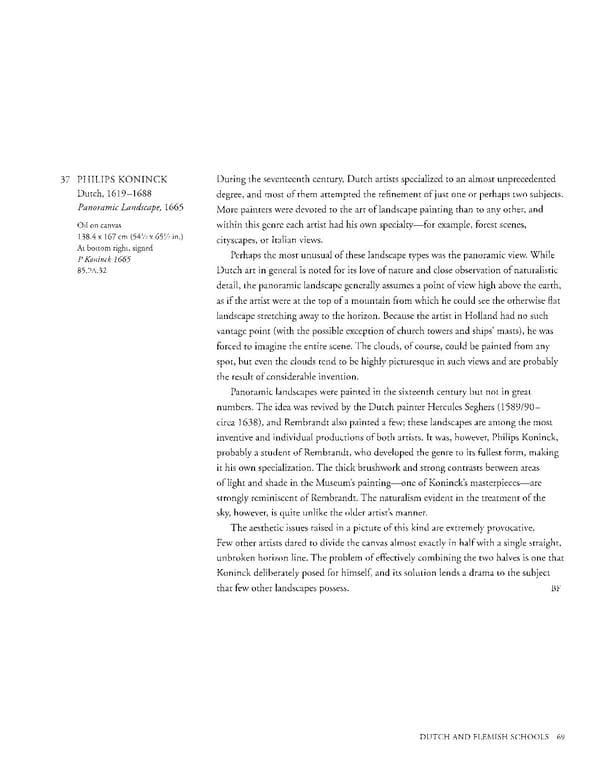37 PHILIPS KONINCK During the seventeenth century, Dutch artists specialized to an almost unprecedented Dutch, 16191688 degree, and most of them attempted the refinement of just one or perhaps two subjects. Panoramic Landscape, 1665 More painters were devoted to the art of landscape painting than to any other, and Oil on canvas within this genre each artist had his own specialty—for example, forest scenes, 138.4 x 167 cm (54½ x 65½ in.) cityscapes, or Italian views. At bottom right, signed P Koninck 1665 Perhaps the most unusual of these landscape types was the panoramic view. While 85.PA.32 Dutch art in general is noted for its love of nature and close observation of naturalistic detail, the panoramic landscape generally assumes a point of view high above the earth, as if the artist were at the top of a mountain from which he could see the otherwise flat landscape stretching away to the horizon. Because the artist in Holland had no such vantage point (with the possible exception of church towers and ships' masts), he was forced to imagine the entire scene. The clouds, of course, could be painted from any spot, but even the clouds tend to be highly picturesque in such views and are probably the result of considerable invention. Panoramic landscapes were painted in the sixteenth century but not in great numbers. The idea was revived by the Dutch painter Hercules Seghers (1589/90 circa 1638), and Rembrandt also painted a few; these landscapes are among the most inventive and individual productions of both artists. It was, however, Philips Koninck, probably a student of Rembrandt, who developed the genre to its fullest form, making it his own specialization. The thick brushwork and strong contrasts between areas of light and shade in the Museum's painting—one of Koninck's masterpieces—are strongly reminiscent of Rembrandt. The naturalism evident in the treatment of the sky, however, is quite unlike the older artist's manner. The aesthetic issues raised in a picture of this kind are extremely provocative. Few other artists dared to divide the canvas almost exactly in half with a single straight, unbroken horizon line. The problem of effectively combining the two halves is one that Koninck deliberately posed for himself, and its solution lends a drama to the subject that few other landscapes possess. BF DUTCH AND FLEMISH SCHOOLS 69
 Masterpieces of the Getty Museum: Paintings Page 69 Page 71
Masterpieces of the Getty Museum: Paintings Page 69 Page 71